|
|
|
Sort Order |
|
|
|
Items / Page
|
|
|
|
|
|
|
| Srl | Item |
| 1 |
ID:
184787
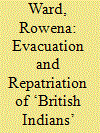

|
|
|
|
|
| Summary/Abstract |
In 1940, the Indian population resident in Japan was estimated at over 500. With the potential for war with Japan increasing, the British embassy in Tokyo advised locally resident British subjects to leave in October 1940 and again in February 1941. However, some, including a number of Indians, chose not to leave. This article considers the evacuation of the Indian population from Japan before December 1941 as well as those who departed as part of the wartime Anglo-Japanese Civilian Exchange. In doing so, it discusses the use of the SS Anhui to evacuate British subjects and also the lack of safe conduct for the City of Paris, which carried the Indian repatriates back to Bombay.
|
|
|
|
|
|
|
|
|
|
|
|
|
|
|
|
| 2 |
ID:
155641
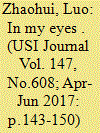

|
|
|
| 3 |
ID:
143863
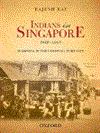

|
|
|
|
|
| Publication |
New Delhi, Oxford University Press, 2014.
|
| Description |
xxix, 325p.: tableshbk
|
| Standard Number |
9780198099291
|
|
|
|
|
|
|
|
|
|
|
|
Copies: C:1/I:0,R:0,Q:0
Circulation
| Accession# | Call# | Current Location | Status | Policy | Location |
| 058577 | 959.5700491411/RAI 058577 | Main | On Shelf | General | |
|
|
|
|
| 4 |
ID:
032658
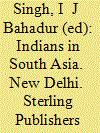

|
|
|
|
|
| Publication |
New Delhi, Sterling Publishers Private Ltd, 1984.
|
| Description |
iv, 268p.
|
|
|
|
|
|
|
|
|
|
|
|
Copies: C:1/I:0,R:0,Q:0
Circulation
| Accession# | Call# | Current Location | Status | Policy | Location |
| 022273 | 305.8954054/BAH 022273 | Main | On Shelf | General | |
|
|
|
|
| 5 |
ID:
096046
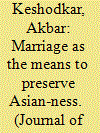

|
|
|
|
|
| Publication |
2010.
|
| Summary/Abstract |
The question of identity, shaped by issues of race and ethnicity, is paramount in the multi-cultural ethnic landscape of Zanzibar. This article examines how the present-day Asian community of Zanzibar, decimated by the 1964 Revolution, when an African insurgence overthrew the islands' Arab rule and expelled the majority of Arabs and Asians, survived in Zanzibar in the years following the Revolution and how, through demarcating communal boundaries and exercising specific marriage strategies, it has managed to maintain its distinct Asian identity. The article is based on anthropological fieldwork in Zanzibar.
|
|
|
|
|
|
|
|
|
|
|
|
|
|
|
|
| 6 |
ID:
149301
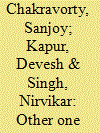

|
|
|
|
|
| Publication |
New Delhi, Oxford University Press, 2017.
|
| Description |
xxvi, 355p.hbk
|
| Standard Number |
9780199475063
|
|
|
|
|
|
|
|
|
|
|
|
Copies: C:1/I:0,R:0,Q:0
Circulation
| Accession# | Call# | Current Location | Status | Policy | Location |
| 058904 | 305.89/CHA 058904 | Main | On Shelf | General | |
|
|
|
|
| 7 |
ID:
109852
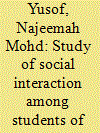

|
|
|
|
|
| Publication |
2012.
|
| Summary/Abstract |
The purpose of this study is to examine the social interaction among students of various ethnic groups at Vision Schools in Malaysia. The focus is mainly on Malays, Chinese and Indians with a sample size of 642 students. This research applies the quantitative and qualitative approach. For the qualitative approach, the researcher used focus group interviews and observations to examine social interaction among students of various ethnic groups. In this research there is one independent variable to explain and predict eleven independent variables. Hypotheses were analysed using post-hoc and multivariate analysis at a p < 0.05 significance level. Findings of the study indicated there were significant difference in the mean score levels for all the independent variables. Study showed high social distance scale for Malay and Chinese students. All the dependent variables effected social interaction among students. Based on the results various suggestions have been recommended and it is hoped that these suggestions will help those involved in teaching and learning to have a better understanding concerning social interaction among Malay, Chinese and Indian students at Vision Schools in Malaysia.
|
|
|
|
|
|
|
|
|
|
|
|
|
|
|
|
| 8 |
ID:
158469


|
|
|
|
|
| Summary/Abstract |
American Indian/Alaska Native education – the training for life of children, adolescents, and adults – has been locked in battle for centuries with colonial schooling, which continues to the present day. Settler societies have used schools to “civilize” Indigenous peoples and to train Native peoples in subservience while dispossessing them of land. Schools are the battlegrounds of American Indian education in which epistemologies, ontologies, axiologies, pedagogies, and curricula clash. In the last century, Native nations, communities, parents, and students have fought tenaciously to maintain heritage languages and cultures – their ways of being in the world – through Indigenous education and have demanded radical changes in schools. Contemporary models of how educators are braiding together Indigenous education and Indigenous schooling to better serve Native peoples provide dynamic, productive possibilities for the future.
|
|
|
|
|
|
|
|
|
|
|
|
|
|
|
|
|
|
|
|
|